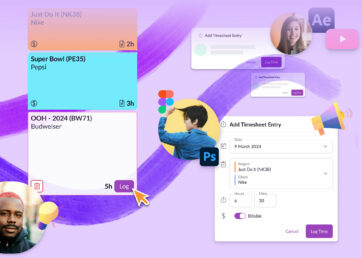Running an agency is not exactly a walk in the park. Agencies face plenty of challenges—spanning from cultural problems to client issues. The best way to deal with agency challenges? Head on. That starts with acknowledging that there’s an issue and coming up with solutions.
Here, we’re listing the most common challenges that agencies face and how to tackle them. Plus, we get some expert insights on one of advertising’s longest-standing issues, diversity and inclusion.
In this article 📖
28 key challenges of agencies today
Before we dive in, it’s important to remember that each agency challenge comes with its own layers of complexity as well as its unique set of solutions. As you read on, also bear in mind that agency challenges will look different for every agency.
1. Communication
While this is not a unique agency challenge, communication is at the heart of any good client relationship. But with many different stakeholders in play, agencies are dealing with another level of complexity.
- Challenge: Poor communication can lead to misunderstandings, errors, and delays.
- Solution: Implement clear communication protocols, hold regular team meetings, and use collaboration tools to streamline communication.
2. Processes
Processes are what keep projects moving forward and help you deliver consistent work. But it can be difficult to stay on top of and tweak them when needed, as client work gets in the way.
- Challenge: Inefficient or outdated processes can hinder productivity.
- Solution: Review and optimize workflows, automate repetitive tasks, and use project management software for better process management.
Read more about agency processes
3. Finding and retaining talent
The agency world was heavily impacted by the Great Resignation, with employees asking for better working conditions—even more so than better pay. Once again, while it’s not a unique agency challenge, this might very well be one of the biggest challenges for agencies right now.
- Challenge: Talent shortages and high turnover can be costly.
- Solution: Invest in recruitment efforts, offer competitive compensation, provide growth opportunities, and foster a positive workplace culture.
4. Retaining clients
Retaining clients is all about building great relationships, and that already begins during client onboarding.
- Challenge: Client churn can impact revenue and profitability.
- Solution: Focus on client satisfaction, deliver outstanding service, maintain open communication, and regularly assess and address client needs.
Read more about agency client retention
5. Time tracking
Time tracking is a constant struggle for agencies. It can be hard to have full visibility of time spent on a project, let alone an account. But with efficient resource planning, you’ll have a much better idea of time spent on projects.
- Challenge: Efficiently managing time-related aspects.
- Solution: Use time tracking software, set realistic project timelines, and prioritize tasks effectively.
💡 Pro tip: Accurate resource allocation and scheduling can help you plan your team’s time upfront, making time tracking and filling out (tedious) timesheets so much faster.
Read more about agency resource planning
6. Managing project scope
Every project needs a well-defined project scope to manage client expectations and avoid scope creep.
- Challenge: Missed deadlines can harm client relationships and reputation.
- Solution: Create realistic project schedules, assign tasks early, and monitor progress closely to meet deadlines.
7. New client acquisition
Yes, client retention is crucial, but if you’re looking to grow your agency and expand into new markets, new client acquisition is a must.
- Challenge: Finding and acquiring new clients can be competitive and time-consuming.
- Solution: Develop a robust marketing strategy, network, leverage referrals, and showcase your agency’s expertise through thought leadership.
8. Scaling
Scaling an agency isn’t easy. For starters, you need to nail agency operations before you even think about scaling.
- Challenge: Scaling up operations without sacrificing quality.
- Solution: Develop a scaling growth strategy, invest in scalable infrastructure, and hire strategically.
Read more about how to scale an agency
9. Agency tech stack
Whether you’re using your own tools, tools that are dictated by your client, or a mix of both—the agency tech stack is getting increasingly complex.
- Challenge: Staying updated with technology and software advancements. Plus, having too many solutions in an expensive and confusing tech stack that do the same thing.
- Solution: Invest in relevant tools, provide training, and continuously evaluate, remove unused, and integrate new technologies.
Read more about how to build an agency tech stack
10. Finding a niche
Whether you’re combining an industry focus with your local market or focusing solely on a category of services, finding a niche helps agencies stand out.
- Challenge: Standing out in a crowded market requires specialization.
- Solution: Identify a unique niche, become an expert in that area, and tailor your services to cater to niche clients.
11. Differentiation
Differentiation is different from finding a niche. For example, there are plenty of creative agencies out there offering the same services. But perhaps one has a charity component to their work and another offers better climate compensation. Whatever your differentiator is, make sure it’s authentic.
- Challenge: Differentiating from competitors is essential for success.
- Solution: Identify and emphasize unique selling points, showcase success stories, and invest in branding.
12. Micromanagement
Whether you’re dealing with difficult clients or have trust issues in-house, nothing kills morale faster than micromanagement.
- Challenge: Micromanaging can stifle creativity and employee morale.
- Solution: Foster trust, delegate tasks, and provide autonomy to employees while maintaining clear expectations.
Read 5 tips to avoid micromanagement for remote teams
13. Efficiencies
Running an agency is all about creating efficiencies, especially if you’re in the middle of a more competitive economy.
- Challenge: Inefficiencies can lead to wasted time and resources.
- Solution: Continuously assess and improve processes, automate tasks, and encourage feedback from team members.
Read more about agency efficiency
14. Culture
A great agency culture is a competitive advantage, especially when employees are looking for a better work-life balance.
- Challenge: Maintaining a positive company culture can be challenging, especially in remote work environments.
- Solution: Cultivate a strong culture by defining core values, engaging employees, and organizing team-building activities.
Read more about agency culture
15. Conflict
Agencies are no stranger to internal conflict. Agency culture is known for its lack of work-life balance and—at times— toxic work cultures, all of which damage not only employee morale but can quickly seep into client relationships.
- Challenge: Conflict within the team can disrupt workflow and morale.
- Solution: Address conflicts promptly, promote open dialogue, and consider conflict resolution training.
16. Motivation
Motivation isn’t a constant. It’s natural for it to fluctuate, but project managers should identify ways to keep teams going, even when the going gets tough.
- Challenge: Employee motivation can fluctuate, affecting productivity.
- Solution: Recognize and reward achievements, provide opportunities for professional growth, and foster a motivating work environment.
💡 Pro tip: Getting into a flow state can also help reduce distractions and boost motivation and productivity.
Read about how to get to a flow state for project teams
17. Budgets
It’s not uncommon that clients want agencies to squeeze more out of their budgets than what they bargained for. But whether it’s a product placement in the next Fast and Furious movie or a Facebook campaign, budget management will keep everyone on the same page in the end.
- Challenge: Managing budgets effectively is crucial for profitability.
- Solution: Develop detailed project budgets, track expenses, and regularly review financial performance.
18. Economy and pricing
It can be difficult to offer competitive pricing when the economic climate is harsh and inflation is going nowhere but up. However, agencies are also facing tension with clients due to a lack of transparency in pricing.
- Challenge: Economic fluctuations can impact pricing and profitability.
- Solution: Adjust pricing strategies as needed, diversify client portfolios, and maintain financial flexibility.
19. Cash flow
Cash flow is king. It all starts with understanding the revenue your agency has generated and how much is being used in a given period. If you don’t, you can run into cash flow issues fast.
- Challenge: Uneven cash flow can lead to financial difficulties.
- Solution: Implement cash flow forecasting, set aside reserves, and negotiate payment terms with clients and suppliers.
20. Data
Most businesses run into challenges with centralizing data, but when you’re dealing with many different clients and accounts, data democracy turns into an entirely different beast.
- Challenge: Managing and leveraging data effectively for insights.
- Solution: Implement data analytics tools, establish data governance policies, and train staff on data utilization, or hire data consultants.
21. Competition
Competition in the agency world is fierce, whether you’re fighting over the top spot for the Super Bowl or a Cannes Lion win.
- Challenge: Fierce competition can make it challenging to win clients.
- Solution: Continuously assess competitors, differentiate your services, and emphasize your agency’s strengths.
22. Social media shifts
The social media landscape is always changing, and even though you feel like you’re on top of the latest trends, your advantage might be hanging by a thread. (Get it?) And perhaps this is why 25% of social media marketers are planning on switching professions.
- Challenge: Constant changes in social media platforms and algorithms.
- Solution: Stay updated on industry trends, adapt strategies, and diversify the social media platforms used.
23. Remote work
With the remote work trend going nowhere, agencies are fighting to retain employees and figuring out how to get a former office culture to thrive online.
- Challenge: Managing remote teams effectively.
- Solution: Use collaboration tools, establish clear communication practices, offer coworking budgets, and promote work-life balance.
Discover what 10 years of working remotely has taught the Resource Guru team

Agency offices everywhere are trying to figure out the balance between office and remote, pictured here, 22 Squared‘s Atlanta office.
24. Changing digital trends
The digital landscape moves fast—probably faster than ever. Whether it’s new technologies and tools or a change in online behavior and attitudes, agencies everywhere find it difficult to stay current.
- Challenge: Keeping up with evolving digital marketing trends.
- Solution: Continuously educate your team, attend conferences, experiment with new strategies, and adapt to emerging trends.
25. Lack of training
Upskilling and knowledge-sharing are key components of a thriving agency culture. But all too often, agencies are too busy with client work to have time to invest in training for employees.
- Challenge: Insufficient training can hinder employee development.
- Solution: Develop training programs, offer learning opportunities, and invest in skill development.
26. Privacy issues
More data is being collected than ever before, and agencies all over the world want to make sure we don’t have another Cambridge Analytica incident on our hands. After all, that’s not good for business.
- Challenge: Ensuring client data privacy and compliance.
- Solution: Implement data security measures, educate employees and clients on privacy regulations, understand compliance across different sectors and countries, and maintain compliance.
27. Climate impact
Agencies aren’t exactly known for their small carbon footprint. In fact, The Advertised Emissions study reported that between 2019 and 2022, the advertising industry’s emissions rose by 11%. But by now, everyone knows that caring about climate impact isn’t just good for the planet, it’s also good for business.
- Challenge: Reduce carbon emissions while keeping clients happy.
- Solution: Implement climate policies, set green goals, and optimize agency processes.
28. General industry changes
Every industry faces disruptions, but perhaps the agency world more so than most. It has to deal with constant changes in consumer behavior, complicated market dynamics, and not to mention the technology that accelerates it all.
- Challenge: Keeping up with industry shifts and disruptions.
- Solution: Stay informed, adapt strategies, and embrace innovation and change.
Now we’ve talked about general agency challenges, we’ll dive into three additional example challenges that specific types of agencies experience, starting with challenges facing advertising agencies.
Advertising agency challenges: Diversity and inclusion
Ad agency challenges are a dime a dozen. Diversity and inclusion may only be a drop in the ocean when it comes to challenges faced by advertising agencies, but it’s one that’s been getting louder and louder in recent years.
In fact, diversity in recent years has worsened—especially in leadership and creative roles.
- Challenge: Fostering a culture of diversity and inclusion.
- Solution: Create DEI (Diversity, Equity, and Inclusion) strategies that have buy-in from leadership.
We spoke to Keli Anaya, a DEI leader with an extensive agency background. His take? It’s all rooted in culture.
“The challenge is setting up a strategy that encourages a culture where DEI is foundational,” he says. “Executive management needs to take the lead on this, but as we all know, the majority of leaders in the industry are white. They often don’t have marginalized experiences to lean on. And that’s fine. But that means they need to listen to the people that do have those experiences and give those people the opportunity to propose DEI strategies that can make the business better for everyone. Which—ultimately—only helps the business grow.”
Keli emphasizes that “everyone gets that ‘the work’ comes first—it’s what makes everyone money. But without a diversity of people in a room with equitable space at the table, we get Burger King thinking women should be in the kitchen, Kendall Jenner giving a Pepsi to a cop, or Starbucks deadnaming trans people.”
The way Keli sees it, there’s no better time than the present to challenge the status quo of agency culture.

Pepsi ended up pulling this ad featuring Kendall Jenner, accused of trivializing the Black Lives Matter movement.
Challenges faced by a digital agency: Here comes AI
AI is the topic on everyone’s tongue. Digital agencies in particular are both excited about the opportunities and concerned about the implications. But most of all, they’re trying to figure out how to effectively incorporate AI into their marketing strategies without crossing any ethical boundaries.
- Challenge: Incorporating AI in an authentic way that doesn’t harm end users.
- Solution: Establish ethical frameworks and only invest in AI solutions relevant to your agency’s services, provide training, and consult with AI experts before implementing any solutions.
In-house agency challenges: Resource constraints
In-house agencies (IHAs) have become increasingly popular among bigger businesses as they offer more control, efficiency, and cost savings in their marketing initiatives. But just because you’re an in-house agency doesn’t mean you get everything you ask for.
Like any organizational structure, IHAs face their own set of challenges, resource constraints being one of the toughest challenges.
- Challenge: IHAs often have limited resources, both in terms of talent and budget.
- Solution: Assess the strategic importance of each project and prioritize them accordingly.
3 ways to avoid common challenges that agencies face
Staying on top of agency challenges requires a proactive approach and a commitment to ongoing improvement. It’s not a “set it and forget it” type thing.
While tackling agency challenges seems like a challenge in itself, the answers lie in making sure the foundations are in place, to help avoid the challenges that pop up in the first place.
1. Comprehensive project scoping and planning
A significant challenge for agencies is scope creep, where the project’s scope expands beyond the original agreement. To avoid this issue:
- Create a detailed project scope: Start each project with a well-defined project scope document. This should outline project objectives, deliverables, timelines, budgets, and responsibilities. Ensure that both the agency and the client agree on this scope.
- Establish a change control process: Establish a formal change control process. If the client requests changes to the project scope, document these changes, assess their impact on the timeline and budget, and obtain client approval before proceeding. This helps prevent uncontrolled scope expansion.
- Hold regular review meetings: Hold regular project review meetings with clients to ensure alignment with the project scope and address any emerging issues or concerns promptly. Effective communication can prevent misunderstandings and misalignment.
2. Robust client onboarding and expectation-setting
Misaligned expectations and communication breakdowns can lead to dissatisfaction and disputes. To avoid these challenges:
- Deliver thorough client onboarding: Develop a comprehensive client onboarding process. During onboarding, educate clients about your agency’s processes, communication channels, and expectations. Ensure clients understand their role across the project life cycle.
- Create clear contracts and agreements: Draft clear, legally binding contracts that specify the terms, responsibilities, deliverables, payment schedules, and dispute resolution mechanisms. Contracts provide a framework for a successful partnership.
- Regular progress updates: Maintain regular communication with clients throughout the project. Provide progress updates, share results, and discuss any deviations from the plan. Transparency fosters trust and minimizes surprises.
3. Effective resource management
Resource mismanagement can lead to budget overruns, missed deadlines, and client dissatisfaction. To avoid resource-related challenges:
- Resource allocation: Properly allocate resources, including talent, time, and budget, based on project requirements. Avoid overloading team members, as this can lead to burnout and reduced quality of work.
- Capacity planning: Implement capacity planning to ensure that your agency can handle the workload effectively. Avoid overcommitting to projects that may strain your resources.
- Project forecasting and reporting: Use project management tools to track resource utilization, project progress, and budgets. Regularly review these metrics to identify potential issues early and course correct if needed.
A challenging future ahead
Whether we’re talking about losing clients to AI or marketing to Gen Z, one thing is certain: agencies are facing a challenging future.
So who will thrive? The agencies that build their business with longevity in mind. That means investing in processes, resource management, and operations. If you don’t create a solid foundation for your agency to stand on—one that enables you to cater to your clients and adapt to new market conditions—your agency’s life span might be as brief as that of Crystal Pepsi.
So invest in your people, culture, and processes first—then clients, creativity, and cash flow will follow.






